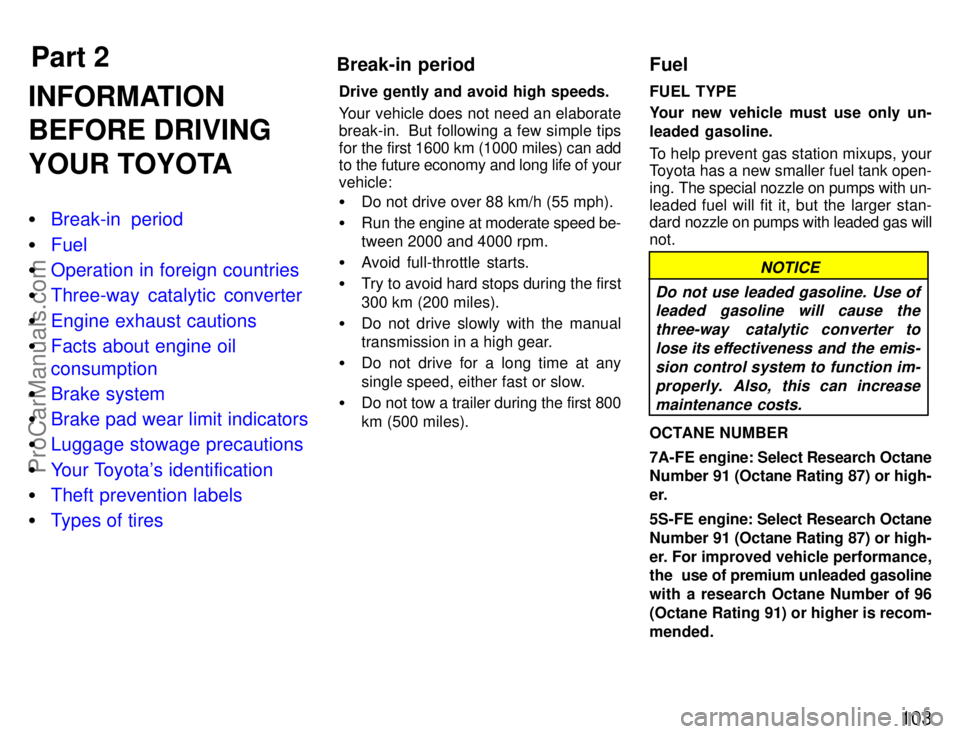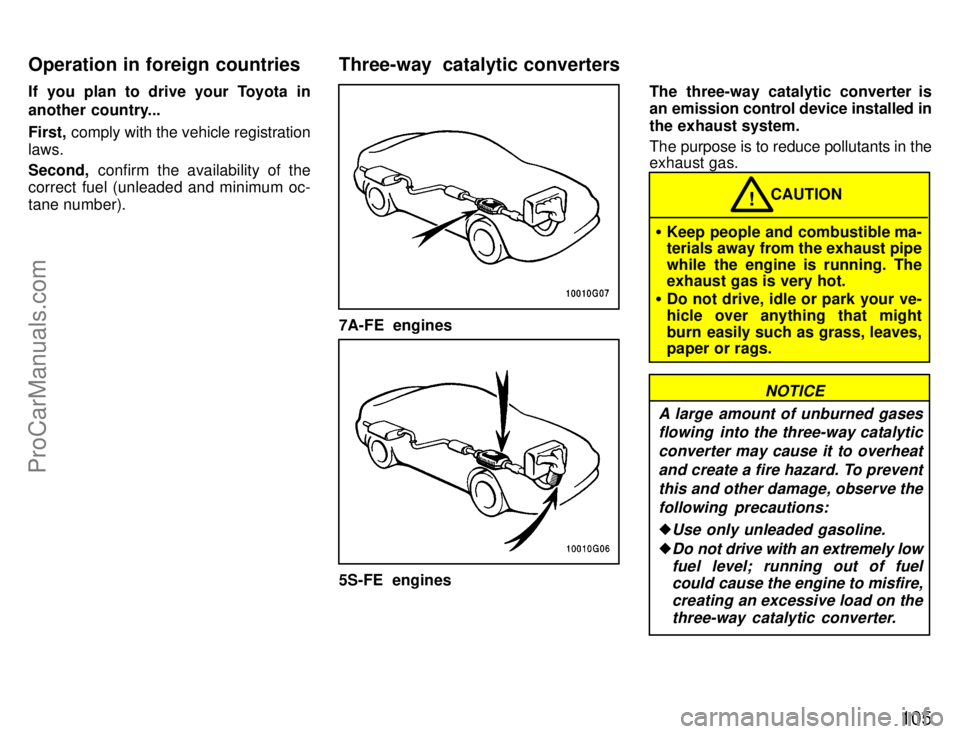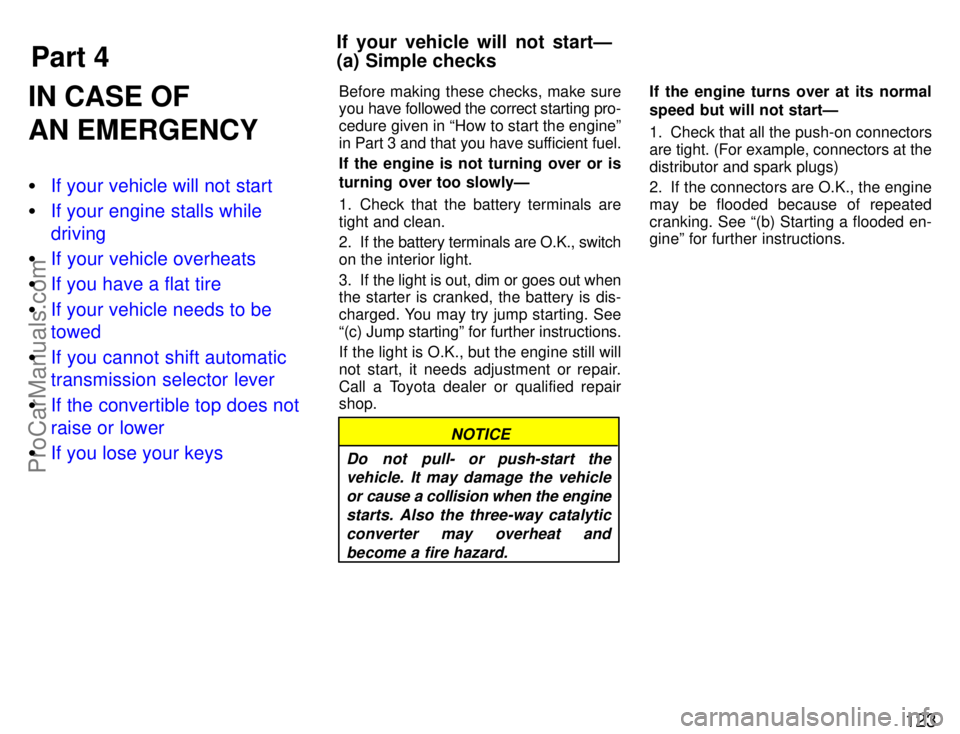Page 110 of 203

Part 2Break-in periodFuel
103
INFORMATION
BEFORE DRIVING
YOUR TOYOTA
�Break-in period
� Fuel
� Operation in foreign countries
� Three-way catalytic converter
� Engine exhaust cautions
� Facts about engine oil
consumption
� Brake system
� Brake pad wear limit indicators
� Luggage stowage precautions
� Your Toyota's identification
� Theft prevention labels
� Types of tires
Drive gently and avoid high speeds.
Your vehicle does not need an elaborate
break-in. But following a few simple tips
for the first 1600 km (1000 miles) can add
to the future economy and long life of your
vehicle:
� Do not drive over 88 km/h (55 mph).
� Run the engine at moderate speed be-
tween 2000 and 4000 rpm.
� Avoid full-throttle starts.
� Try to avoid hard stops during the first
300 km (200 miles).
� Do not drive slowly with the manual
transmission in a high gear.
� Do not drive for a long time at any
single speed, either fast or slow.
� Do not tow a trailer during the first 800
km (500 miles). FUEL TYPE
Your new vehicle must use only un-
leaded gasoline.
To help prevent gas station mixups, your
Toyota has a new smaller fuel tank open-
ing.
The special nozzle on pumps with un-
leaded fuel will fit it, but the larger stan-
dard nozzle on pumps with leaded gas will
not.
NOTICE
Do not use leaded gasoline. Use of leaded gasoline will cause the
three-way catalytic converter tolose its effectiveness and the emis-sion control system to function im-properly. Also, this can increasemaintenance costs.
OCTANE NUMBER
7A-FE engine: Select Research Octane
Number 91 (Octane Rating 87) or high-
er.
5S-FE engine: Select Research Octane
Number 91 (Octane Rating 87) or high-
er. For improved vehicle performance,
the use of premium unleaded gasoline
with a research Octane Number of 96
(Octane Rating 91) or higher is recom-
mended.
ProCarManuals.com
Page 112 of 203

105
If you plan to drive your Toyota in
another country...
First, comply with the vehicle registration
laws.
Second, confirm the availability of the
correct fuel (unleaded and minimum oc-
tane number).
7A-FE engines
5S-FE engines The three-way catalytic converter is
an emission control device installed in
the exhaust system.
The purpose is to reduce pollutants in the
exhaust gas.
CAUTION!
�
Keep people and combustible ma-
terials away from the exhaust pipe
while the engine is running. The
exhaust gas is very hot.
� Do not drive, idle or park your ve-
hicle over anything that might
burn easily such as grass, leaves,
paper or rags.
A large amount of unburned gases
flowing into the three-way catalytic
converter may cause it to overheatand create a fire hazard. To preventthis and other damage, observe thefollowing precautions:
�Use only unleaded gasoline.
�Do not drive with an extremely lowfuel level; running out of fuelcould cause the engine to misfire,
creating an excessive load on thethree-way catalytic converter.
NOTICE
Three-way catalytic converters
Operation in foreign countries
ProCarManuals.com
Page 113 of 203

106
�Do not allow the engine to run atidle speed for more than 20 min-
utes.
�Avoid racing the engine.
�Do not push-start or pull-startyour vehicle.
�Do not turn off the ignition whilethe vehicle is moving.
�Keep your engine in good running
order. Malfunctions in the engine electrical system, electronic igni-
tion system/distributor ignitionsystem or fuel system couldcause an extremely high three-
way catalytic converter tempera-ture.
�If the engine becomes difficult tostart or stalls frequently, take your
vehicle in for a check-up as soon as possible. Remember, your To-
yota dealer knows your vehicleand its three-way catalytic con-verter system best.
�To ensure that the three-way cata-
lytic converter and the entireemission control system operate
properly, your vehicle must re-ceive the periodic inspections re-quired by the T oyota Maintenance
Schedule. For scheduled mainte- nance information, refer to the
separate Owner's Manual Sup-plement/Maintenance Scheduleº.
CAUTION!
� Avoid inhaling the engine exhaust.
It contains carbon monoxide,
which is a colorless and odorless
gas. It can cause unconsciousness
or even death.
� Make sure the exhaust system has
no holes or loose connections. The
system should be checked from
time to time. If you hit something,
or notice a change in the sound of
the exhaust, have the system
checked immediately.
� Do not run the engine in a garage or
enclosed area except for the time
needed to drive the vehicle in or
out. The exhaust gases cannot es-
cape, making this a particularly
dangerous situation.
� Do not remain for a long time in a
parked vehicle with the engine run-
ning. If it is unavoidable, however,
do so only in an unconfined area
and adjust the heating or cooling
system to force outside air into the
vehicle.
�Keep the trunk lid or back door
closed while driving. An open or
unsealed trunk lid or back door
may cause exhaust gases to be
drawn into the vehicle. If you must
drive with the trunk or back door lid
open to accommodate a large ob-
ject, close the windows, open all
the instrument panel vents and
have the heating or cooling system
deliver fresh air into the vehicle by
turning the fan to high speed with
the air intake control lever set at the
outside air position.
� To allow proper operation of your
vehicle's ventilation system, keep
the inlet grilles in front of the wind-
shield clear of snow, leaves, or oth-
er obstructions.
� If you smell exhaust fumes in the
vehicle, drive with the windows
open and the trunk lid or back door
closed. Have the cause immediate-
ly located and corrected.
Engine exhaust cautions
ProCarManuals.com
Page 130 of 203

Part 4
If your vehicle will not startÐ
(a) Simple checks123
IN CASE OF
AN EMERGENCY
�If your vehicle will not start
� If your engine stalls while
driving
� If your vehicle overheats
� If you have a flat tire
� If your vehicle needs to be
towed
� If you cannot shift automatic
transmission selector lever
� If the convertible top does not
raise or lower
� If you lose your keys
Before making these checks, make sure
you have followed the correct starting pro-
cedure given in How to start the engineº
in Part 3 and that you have sufficient fuel.
If the engine is not turning over or is
turning over too slowlyÐ
1. Check that the battery terminals are
tight and clean.
2. If the battery terminals are O.K., switch
on the interior light.
3. If the light is out, dim or goes out when
the starter is cranked, the battery is dis-
charged. You may try jump starting. See
(c) Jump startingº for further instructions.
If the light is O.K., but the engine still will
not start, it needs adjustment or repair.
Call a Toyota dealer or qualified repair
shop.
NOTICE
Do not pull- or push-start the vehicle. It may damage the vehicle
or cause a collision when the enginestarts. Also the three-way catalyticconverter may overheat andbecome a fire hazard.
If the engine turns over at its normal
speed but will not startÐ
1. Check that all the push-on connectors
are tight. (For example, connectors at the
distributor and spark plugs)
2. If the connectors are O.K., the engine
may be flooded because of repeated
cranking. See (b) Starting a flooded en-
gineº for further instructions.
ProCarManuals.com